nature
tours & travel, wildlife tours, adventure travel and general
travel to Australia, Southeast Asia, South America and Alaska
Guyana
Wildlife Tour continues
Day
4 – Sunday, September 9: Iwokrama
We begin today with an early morning excursion along the extensive
trail systems which allow good access into
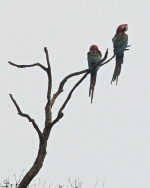 the
forest. Rainforest mammals, though never conspicuous, are well represented
at Iwokrama and with luck we may encounter the Banded Tamandua.
Several various interesting, and high priority birds for birders,
such as Spotted Antpitta and Rufous-winged Ground-cuckoo are possible
here, and our extra time makes them more likely than shorter visits.
Agoutis can almost be guaranteed, and in the evening we’ll
be out with lights in search of potoos, owls and mammals such as
Kinkajou and Olingo, plus amphibians and reptiles. Tapir are not
uncommon here, but their tracks are seen and voices heard more often
than they are seen. However, we have plenty of time for wildlife
searching, our expert guide will ensure we make the most of our
time here. (BLD)
the
forest. Rainforest mammals, though never conspicuous, are well represented
at Iwokrama and with luck we may encounter the Banded Tamandua.
Several various interesting, and high priority birds for birders,
such as Spotted Antpitta and Rufous-winged Ground-cuckoo are possible
here, and our extra time makes them more likely than shorter visits.
Agoutis can almost be guaranteed, and in the evening we’ll
be out with lights in search of potoos, owls and mammals such as
Kinkajou and Olingo, plus amphibians and reptiles. Tapir are not
uncommon here, but their tracks are seen and voices heard more often
than they are seen. However, we have plenty of time for wildlife
searching, our expert guide will ensure we make the most of our
time here. (BLD)
Day
5 - Monday, September 10: Iwokrama/Atta
An early start this morning, before dawn, to travel to Atta, still
within the Iwokrama forest. The road we’ll be traveling on
is considered the best place in Guyana for Jaguar – the both
cross and 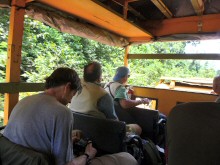 saunter
along the
saunter
along the road, without too much fear of humans – and as the best place
in Guyana, one of the best in South America. We travel on a Bedford
truck, courtesy WW2, with a covered roof and open sides for viewing.
In addition to keeping a watch for jaguar we will be searching for
other mammals such as sloths, any reptiles crossing the road, and
of course birds as they start their day. We’ll stop at creeks
and similar wet areas for herons and anything else; it will be a
leisurely journey – and different to most tour travel. The
highlight of Atta – and the main reason for staying here –
is the Iwokrama Canopy Walkway, about 500ft of suspension bridges
between 40 and 100ft above the forest floor. In addition to the
canopy fauna we can see, being above the floor ground dwellers such
as Gray-winged Trumpeter and Red-legged Tinamou don’t notice
us, and so we have a better chance of observing them. Birds of note
that may be seen from the walkway are the beautiful Pompadour Coting
road, without too much fear of humans – and as the best place
in Guyana, one of the best in South America. We travel on a Bedford
truck, courtesy WW2, with a covered roof and open sides for viewing.
In addition to keeping a watch for jaguar we will be searching for
other mammals such as sloths, any reptiles crossing the road, and
of course birds as they start their day. We’ll stop at creeks
and similar wet areas for herons and anything else; it will be a
leisurely journey – and different to most tour travel. The
highlight of Atta – and the main reason for staying here –
is the Iwokrama Canopy Walkway, about 500ft of suspension bridges
between 40 and 100ft above the forest floor. In addition to the
canopy fauna we can see, being above the floor ground dwellers such
as Gray-winged Trumpeter and Red-legged Tinamou don’t notice
us, and so we have a better chance of observing them. Birds of note
that may be seen from the walkway are the beautiful Pompadour Coting a,
Caica Parrot (also seen
a,
Caica Parrot (also seen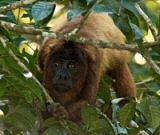 along the road), White-throated Trogon, Guianan Toucanet, Golden-winged
Parakeet and many more. Occasionally seen is the Guianan Saki monkey,
and spider and howler monkeys are often seen feeding. Almost certain
to be heard, and seen is the well-named Screaming Piha. Of additional
interest are Amerindian petroglyphs, and occasion pottery shards,
along the access trail. We’ll spend all day at Atta, with
plenty of time for the canopy and trails, as well as resting up
in the hot middle of the day, after our early start. This evening
we’ll be spotlighting the road by vehicle for mammals, owls,
potoos and reptiles.
(BLD)
along the road), White-throated Trogon, Guianan Toucanet, Golden-winged
Parakeet and many more. Occasionally seen is the Guianan Saki monkey,
and spider and howler monkeys are often seen feeding. Almost certain
to be heard, and seen is the well-named Screaming Piha. Of additional
interest are Amerindian petroglyphs, and occasion pottery shards,
along the access trail. We’ll spend all day at Atta, with
plenty of time for the canopy and trails, as well as resting up
in the hot middle of the day, after our early start. This evening
we’ll be spotlighting the road by vehicle for mammals, owls,
potoos and reptiles.
(BLD)
Day
6 – Tuesday, September 11: Atta
We have a full day of birding and wildlife spotting from the walkway
and area trails. This is an opportunity for 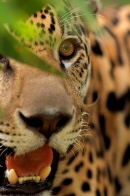 some
personal searching, with our own specific interests in mind, be
they birds, plants, photography or whatever our main interest is.
Naturally our naturalist/birding guide will lead several tours,
as well as being available throughout the day. But everyone will
want to welcome the dawn chorus from the canopy walkway. The clearing
around the lodge is one of the best places to see another of Guyana’s
“must see” birds, the Crimson Fruitcrow. This species
is seen here on a reasonably regular basis, as it often comes to
feed in some of the nearby trees. The clearing is also a reliable
site for Black Curassow, as there is a family party which has become
habituated to people and regularly passes through the clearing.
Those with an interest in photographing wildlife will especially
appreciate the opportunity to photograph this birds, or more likely
birds, given its impressive size and curly topknot feathers. Other
bird species we hope to encounter during our stay include Eastern
Long-tailed Hermit, Crimson Topaz, Great and Paradise J
some
personal searching, with our own specific interests in mind, be
they birds, plants, photography or whatever our main interest is.
Naturally our naturalist/birding guide will lead several tours,
as well as being available throughout the day. But everyone will
want to welcome the dawn chorus from the canopy walkway. The clearing
around the lodge is one of the best places to see another of Guyana’s
“must see” birds, the Crimson Fruitcrow. This species
is seen here on a reasonably regular basis, as it often comes to
feed in some of the nearby trees. The clearing is also a reliable
site for Black Curassow, as there is a family party which has become
habituated to people and regularly passes through the clearing.
Those with an interest in photographing wildlife will especially
appreciate the opportunity to photograph this birds, or more likely
birds, given its impressive size and curly topknot feathers. Other
bird species we hope to encounter during our stay include Eastern
Long-tailed Hermit, Crimson Topaz, Great and Paradise J acamars,
Guianan and Pied Puffbirds, Green and Black-necked Aracaris, Red-billed
Woodcreeper, Black-throated Antshrike, Guianan Streaked Antwren,
Guianan Warbling Antbird, Purple-throated Fruitcrow, Tiny Tyrant-Manakin,
Helmeted Pygmy-Tyrant, Golden-sided
Euphonia and both Red-and-Black and Yellow-green Grosbeaks. Naturally
we’ll be keeping an eye out for the various monkeys seen here,
sloths and other mammals such as Tayra and Jaguarundi, Coatis, Tamarins,
Peccaries and Brocket deer. Night time mammals searched for include
Olingo, Kinkajou, Ocelot and Margay. Our second night here gives
us another opportunity to head out in our designated vehicle for
wildlife spotting, as well as spending time on foot with the lights.
(BLD)
acamars,
Guianan and Pied Puffbirds, Green and Black-necked Aracaris, Red-billed
Woodcreeper, Black-throated Antshrike, Guianan Streaked Antwren,
Guianan Warbling Antbird, Purple-throated Fruitcrow, Tiny Tyrant-Manakin,
Helmeted Pygmy-Tyrant, Golden-sided
Euphonia and both Red-and-Black and Yellow-green Grosbeaks. Naturally
we’ll be keeping an eye out for the various monkeys seen here,
sloths and other mammals such as Tayra and Jaguarundi, Coatis, Tamarins,
Peccaries and Brocket deer. Night time mammals searched for include
Olingo, Kinkajou, Ocelot and Margay. Our second night here gives
us another opportunity to head out in our designated vehicle for
wildlife spotting, as well as spending time on foot with the lights.
(BLD)
Day
7 – Wednesday, September 12: Atta/Rewa
Early morning on the walkway or jungle trails. After breakfast we
travel to a rainforest trail where there is an excellent chance
of spotting the famous Guianan Cock-of-the-Rock. Our Amerindian
guides will take this opportunity to share examples of their vast
knowledge of medicinal plants. If the Harpy Eagle nest is active,
we will visit it on this day. The nest itself is located in a huge
emergent tree only a couple of miles from the village and if we
are extremely fortunate, we may see one of the adult birds bringing
a sloth or monkey to the nest to feed their chick. The trek into
the nest site is about an hour each way on a reasonable trail. Our
journey continues for lunch at Rock View, where we have a good chance
of Buff-necked Ibis and possibly Aplomado Falcon, before continuing
along the road by our trusty Bedford to Kwatamang Landing to board
boats for the 3 hour boat ride to Rewa along the Rupununi River
with  opportunities
to see wild Giant River Otters and Black Caiman. Rewa Village is
located where the Rewa River runs into the Rupununi River in the
North Rupununi. The surrounding area is rainforest, mountains and
oxbow lakes and teeming with wildlife birds and fish. The community
of approximately 220 persons is predominately Macushi with a few
families of the Wapashani and Patamona tribes. Villagers practice
subsistence farming, fishing and hunting with little opportunity
for cash employment. In 20
opportunities
to see wild Giant River Otters and Black Caiman. Rewa Village is
located where the Rewa River runs into the Rupununi River in the
North Rupununi. The surrounding area is rainforest, mountains and
oxbow lakes and teeming with wildlife birds and fish. The community
of approximately 220 persons is predominately Macushi with a few
families of the Wapashani and Patamona tribes. Villagers practice
subsistence farming, fishing and hunting with little opportunity
for cash employment. In 20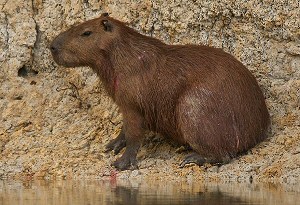 05
the community constructed the Rewa Eco-lodge so that they could
establish a sustainable eco-tourism business. The lodge remains
virtually unknown with only a few hundred visitors to date. The
lodge itself is situated on the river bank overlooking the Rewa
River with views down river to the Rupununi River. We arrive in
05
the community constructed the Rewa Eco-lodge so that they could
establish a sustainable eco-tourism business. The lodge remains
virtually unknown with only a few hundred visitors to date. The
lodge itself is situated on the river bank overlooking the Rewa
River with views down river to the Rupununi River. We arrive in
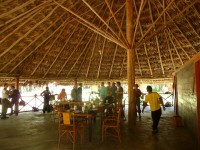 Rewa
in time for a late lunch and an opportunity to cool down around
the shady grounds and along the waterfront. Late this afternoon
we take a boat up the Rewa River and then a 15 minute hike to Grass
Pond. Visit sand banks where giant river turtles come to lay their
eggs. Along the river banks you may see red howler monkeys, squirrel
monkeys and brown capuchin, and this area has a large population
of giant river otters. Grass Pond is about two miles long and is
a beautiful setting with Victoria amazonica, the giant water lily.
It has a good population of Arapaima, (
Rewa
in time for a late lunch and an opportunity to cool down around
the shady grounds and along the waterfront. Late this afternoon
we take a boat up the Rewa River and then a 15 minute hike to Grass
Pond. Visit sand banks where giant river turtles come to lay their
eggs. Along the river banks you may see red howler monkeys, squirrel
monkeys and brown capuchin, and this area has a large population
of giant river otters. Grass Pond is about two miles long and is
a beautiful setting with Victoria amazonica, the giant water lily.
It has a good population of Arapaima, ( reportedly
the highest density in Guyana) the largest fresh water fish in the
world.
reportedly
the highest density in Guyana) the largest fresh water fish in the
world. Those who are interested can fish for dinner; the main catch here
is Peacock Bass. You may see Brown Capuchin Monkey or Capybara.
Birds likely to be seen include Limpkin, Wattled Jacana, Black-
collared Hawk, Green Kingfisher and Guianan Puffbird. As dusk settles
we watch
the flower of the Victoria amazonica bloom, a slow motion event
which unfolds before our eyes. At dinner tonight we'll meet our
hosts and learn about the history of the lodge and the considerable
community effort that has gone into making the lodge a reality,
and once again take an evening walk with our spotlights.
(BLD)
Those who are interested can fish for dinner; the main catch here
is Peacock Bass. You may see Brown Capuchin Monkey or Capybara.
Birds likely to be seen include Limpkin, Wattled Jacana, Black-
collared Hawk, Green Kingfisher and Guianan Puffbird. As dusk settles
we watch
the flower of the Victoria amazonica bloom, a slow motion event
which unfolds before our eyes. At dinner tonight we'll meet our
hosts and learn about the history of the lodge and the considerable
community effort that has gone into making the lodge a reality,
and once again take an evening walk with our spotlights.
(BLD)
Day 8 – Thursday, September 13: Rewa
We start the day with breakfast at dawn overlooking the Rewa River.
We then head out by boat along the Rupununi River, into an oxbow
lake to begin a hike up Awarmie Mountain. The climb is steep in
a few sections but in general not too difficult, and we’ll
be taking an easy pace with rest stops along the way. Along the
way you may get close up views of Black Spider Monkeys, neotropical
butterflies and day moths, frogs, leaf cutter ants and of course
many species of birds. Less common but resident in this area are
peccaries, armadillos, snakes, and tapirs. Birds that may be seen
include Ornate Hawk-eagle, Black Curassow, Red-fan Parrot, Guianan
Puffbird, Todd’s Antwren, Spotted Tanager and Bay-headed Tanager.
Resident Harpy Eagles are a highlight of the immediate area, with
at least one active nest. The area also has a high density of macaws
including Scarlet, Blue-and-yellow and Red-and- Green
Macaws. At the summit we have absolutely stunning views across rainforest
to the distant mountains; large birds of prey such as Harpy Eagle
and King Vulture may be seen from our perch. There is a small plateau
on the top of the mountain and in one direction, there are uninterrupted
views back to the Rupununi River, some patches of savannah and across
to the distant Kanuku Mountains. In the other direction, there is
a near vertical drop of at least 200m and the view is across great
swathes of undisturbed forest to the distant Iwokrama Mountain and
much closer, Makarapan Mountain.
Green
Macaws. At the summit we have absolutely stunning views across rainforest
to the distant mountains; large birds of prey such as Harpy Eagle
and King Vulture may be seen from our perch. There is a small plateau
on the top of the mountain and in one direction, there are uninterrupted
views back to the Rupununi River, some patches of savannah and across
to the distant Kanuku Mountains. In the other direction, there is
a near vertical drop of at least 200m and the view is across great
swathes of undisturbed forest to the distant Iwokrama Mountain and
much closer, Makarapan Mountain.
We
return to the lodge for lunch, and then take a walk through the
community of Rewa to see how the locals live. Visit villager’s
houses where you can experience their 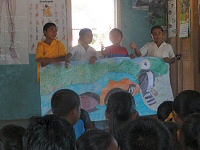 everyday
life and see activities such as grating cassava, weaving baskets
and tending kitchen gardens; we may visit the small school as well,
where the walls are adorned with pictures of local wildlife; the
school curriculum emphasizes the impor
everyday
life and see activities such as grating cassava, weaving baskets
and tending kitchen gardens; we may visit the small school as well,
where the walls are adorned with pictures of local wildlife; the
school curriculum emphasizes the impor tance
and heritage of the natural world. The flowering shrubs along the
lane to the village are particularly good for hummingbirds. Later
this afternoon travel up the Rewa River to a location known as Seawall.
This rock formation is a great place to fish or take in the beauty
of the location. Visit sand banks where giant river turtles come
to lay their eggs. On the return trip as the sun sets we spotlight
for wildlife along the banks where we may see red howler monkeys,
squirrel monkeys and brown capuchin bedding down for the night.
Caimans are also likely.
(BLD)
tance
and heritage of the natural world. The flowering shrubs along the
lane to the village are particularly good for hummingbirds. Later
this afternoon travel up the Rewa River to a location known as Seawall.
This rock formation is a great place to fish or take in the beauty
of the location. Visit sand banks where giant river turtles come
to lay their eggs. On the return trip as the sun sets we spotlight
for wildlife along the banks where we may see red howler monkeys,
squirrel monkeys and brown capuchin bedding down for the night.
Caimans are also likely.
(BLD)
Our
Guyana Wildlife tour continues >>>>>